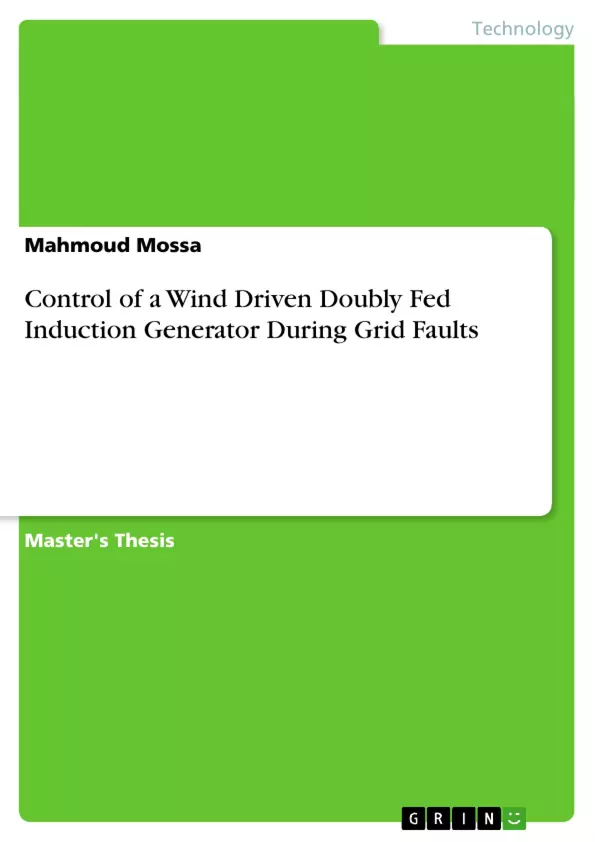Wind electrical power systems are recently getting lot of attention, because
they are cost competitive, environmental clean and safe renewable power
source, as compared with fossil fuel and nuclear power generation. A special
type of induction generator, called a doubly fed induction generator (DFIG),
is used extensively for high-power wind applications. They are used more
and more in wind turbine applications due to ease controllability, high
energy efficiency and improved power quality.
This thesis aims to develop a method of a field orientation scheme for
control both the active and reactive powers of a DFIG driven by a wind
turbine.The proposed control system consists of a wind turbine that drives a
DFIG connected to the utility grid through AC-DC-AC link. The main
control objective is to regulate the dc link voltage for operation at maximum
available wind power.This is achieved by controlling the and axes
components of voltages and currents for both rotor side and line side
converters using PI controllers. The complete dynamic model of the
proposed system is described in detail. Computer simulations have been
carried out in order to validate the effectiveness of the proposed system
during the variation of wind speed. The results prove that , better overall
performances are achieved, quick recover from wind speed disturbances in
addition to good tracking ability.
Generally, any abnormalities associated with grid asymmetrical faults are
going to affect the system performance considerably. During grid faults,
unbalanced currents cause negative effects like overheating problems and
mechanical stress due to high torque pulsations that can damage the rotor shaft, gearbox or blade assembly. Therefore, the dynamic model of the
DFIG, driven by a wind turbine during grid faults has been analyzed and
developed using the method of symmetrical components. The dynamic
performance of the DFIG during unbalanced grid conditions is analyzed and
described in detail using digital simulations.
A novel fault ride-through (FRT) capability is proposed (i.e. the ability of
the power system to remain connected to the grid during faults) with suitable
control strategy in this thesis. In this scheme, the input mechanical energy of
the wind turbine during grid faults is stored and utilized at the moment of
fault clearance, instead of being dissipated in the resistors of the crowbar
circuit as in the existing FRT schemes. [...]
Inhaltsverzeichnis (Table of Contents)
- CHAPTER (1)
- INTRODUCTION
- General
- Thesis Objectives
- Thesis Outlines
- CHAPTER (2)
- LITERATURE REVIEW
- Introduction
- Synchronous Generators Driven by a fixed speed Turbine
- Wound Field Synchronous Generator (WFSG) Driven by a wind turbine
- Permanent-Magnet Synchronous Generator (PMSG) Driven by a wind turbine
- Induction Generators Driven by a variable speed wind turbine
- Squirrel Cage Induction Generator (SCIG)
Zielsetzung und Themenschwerpunkte (Objectives and Key Themes)
This thesis delves into the control of a doubly fed induction generator (DFIG) during grid faults, focusing on the development of a field orientation scheme for regulating both active and reactive power. The main objective is to ensure stable operation of the DFIG under varying wind speeds and grid disturbances, while optimizing power extraction from the wind turbine.
- Control of a DFIG driven by a wind turbine
- Field orientation scheme for regulating active and reactive power
- Dynamic model of the DFIG during grid faults
- Fault ride-through (FRT) capability for maintaining grid connection during faults
- Optimization of wind energy utilization and system performance during grid disturbances
Zusammenfassung der Kapitel (Chapter Summaries)
Chapter 1 introduces the thesis, outlining its objectives and scope. Chapter 2 provides a comprehensive literature review, exploring various types of generators used in wind turbine applications, particularly focusing on DFIGs. This chapter examines the advantages and disadvantages of different generator configurations, setting the stage for the thesis's proposed solution.
Schlüsselwörter (Keywords)
The main keywords and focus topics of this thesis revolve around the control and performance of a doubly fed induction generator (DFIG) in wind turbine applications. Key themes include field orientation control, grid fault analysis, fault ride-through (FRT) capabilities, wind energy optimization, and system stability during grid disturbances. The work explores the dynamic modeling of the DFIG under varying wind conditions and during grid faults, highlighting the impact of these factors on the generator's performance and control strategies for mitigating negative effects.
- Quote paper
- Mahmoud Mossa (Author), 2013, Control of a Wind Driven Doubly Fed Induction Generator During Grid Faults, Munich, GRIN Verlag, https://www.grin.com/document/209083



